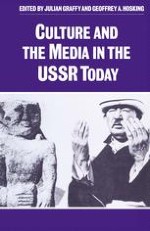1989 | OriginalPaper | Chapter
Soviet Theatre: Glasnost’ in Action — with Difficulty
Author : Michael Glenny
Published in: Culture and the Media in the USSR Today
Publisher: Palgrave Macmillan UK
Included in: Professional Book Archive
Activate our intelligent search to find suitable subject content or patents.
Select sections of text to find matching patents with Artificial Intelligence. powered by
Select sections of text to find additional relevant content using AI-assisted search. powered by
To appreciate fully the changes and reforms that have occurred — and are still occurring — in the Soviet theatre since the ‘Gorbachev era’ began in 1985, some knowledge of its previous state, in particular the legacy of Stalinism, is essential. Under Stalin’s rule the innovative, avant-garde brilliance of the 1920s quickly faded into total extinction. Stalin’s method of controlling — or rather manipulating — the arts and sciences was to set up one person who represented his own views as his ‘dictator’ over each particular field, usually an elderly, respected but conservative figure, and the theatre was no exception. Because Stalin’s tastes were firmly middlebrow and Moscow Arts Theatre productions were his idea of what plays should be like, in 1934 Stanislavskii became Stalin’s appointed ‘dictator’ of theatrical art in the USSR. This had three main effects: first, the rapid disappearance of the Expressionist, non-realistic theatre of which the most brilliant exponent was Meierkhol’d, who was arrested in 1938 and imprisoned in a labour camp, where he died in 1940; second, the imposition of the Stanislavskii method as the only school of acting allowed throughout the USSR and of Moscow Arts Theatre naturalism as the obligatory style in all theatres, resulting in a uniformity and a stifling of all creative experiment that produced twenty years of what Soviet theatre veterans now recall with a shudder as ‘grey realism’.
